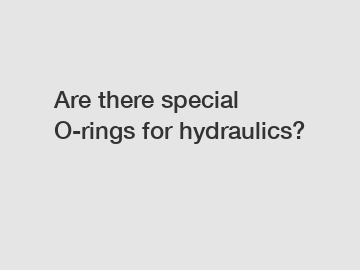Jan. 07, 2024
Rubber & Plastics
Are there special O-rings for hydraulics?
When it comes to hydraulics, reliability and efficiency are key. Whether you are working with heavy machinery or intricate hydraulic systems, ensuring that all components function optimally is of utmost importance. One crucial component that often goes unnoticed but plays a fundamental role in hydraulic systems is the O-ring.
O-rings are simple yet effective sealing devices, designed to prevent leaks and maintain pressure in hydraulic applications. They are usually made of elastomers, which are synthetic rubber-like materials known for their resistance to high temperatures and various chemicals. However, not all O-rings are created equal, and certain hydraulics applications demand special O-rings specifically designed to withstand the unique conditions they encounter.

In hydraulic systems, O-rings face numerous challenges, such as high pressure, extreme temperatures, and exposure to chemicals. Ordinary O-rings may not be able to withstand these conditions, leading to premature failure and costly downtime. That's why specialized O-rings for hydraulics have been developed to address these challenges and ensure the overall efficiency and reliability of hydraulic systems.
One significant difference between regular O-rings and those designed for hydraulics is the selection of materials. Specialized hydraulic O-rings are typically made of nitrile rubber (NBR) or fluorocarbon rubber (FKM). Nitrile rubber O-rings are known for their excellent resistance to petroleum-based oils and fuels, making them an ideal choice for hydraulic applications that involve these substances. On the other hand, fluorocarbon rubber O-rings boast exceptional resistance to a broader range of chemicals, including acids and hydraulic fluids with a high aromatic content.
Moreover, hydraulic O-rings are often designed with additional features to enhance their performance and lifespan. One example is the inclusion of reinforcement additives, such as glass fibers or carbon black. These reinforcements increase the O-ring's tensile strength, making it less prone to extrusion and wear under high pressure. Additionally, specialized hydraulic O-rings may also have anti-extrusion rings or back-up rings installed, further mitigating the risk of failure and ensuring a secure seal.
Temperature fluctuations can pose a significant challenge for hydraulic systems, especially those exposed to extreme heat or cold. To address this, certain O-rings for hydraulics are formulated to withstand a wider temperature range compared to standard O-rings. For instance, silicone-based O-rings can endure both extremely high and low temperatures without losing their elasticity or compromising their sealing efficiency. Therefore, when operating in environments with extreme temperature variations, it is crucial to select hydraulic O-rings specifically designed for these conditions.
Additionally, the size and design of hydraulic O-rings play a crucial role in their performance. Unlike standard O-rings, those used in hydraulics usually have larger cross-sections to accommodate higher pressures. The shape of the groove where the O-ring is seated is also important, as it affects the overall sealing ability. Choosing the correct size and shape of the O-ring, along with proper groove design, ensures a secure seal and minimizes the risk of leaks.
When it comes to hydraulic systems, trustworthiness and reliability are paramount. That's why using specialized O-rings designed explicitly for hydraulics is so important. These O-rings have been engineered to meet the demanding requirements of hydraulic applications and ensure optimal performance and longevity.
In conclusion, while ordinary O-rings may suffice for some applications, hydraulics demand more. The unique challenges faced by hydraulic systems call for specialized O-rings that can withstand high pressure, extreme temperatures, and exposure to various chemicals. These O-rings, made of materials like nitrile rubber or fluorocarbon rubber, with reinforced additives when necessary, are designed to excel in hydraulic applications, ensuring a tight seal and preventing costly leaks. By choosing specialized O-rings for hydraulics and paying attention to their size and design, you can enhance the reliability and efficiency of your hydraulic systems, allowing them to operate smoothly for years to come.
Are you interested in learning more about round rubber seal, china shock absorber oilseal manufacturer, flat rubber seal? Contact us today to secure an expert consultation!
If you are interested in sending in a Guest Blogger Submission,welcome to write for us!
All Comments ( 0 )